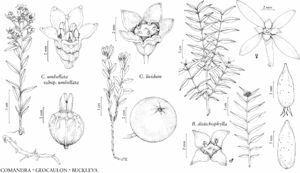Geocaulon lividum
Rhodora 30: 23. 1928.
Stems: rhizomes 1.5–3 mm; aerial shoots 0.7–3 dm. Leaf-blades elliptic, oblong, or obovate, 1.5–5 × 0.5–1 cm, apex obtuse to rounded, thin, flaccid, surfaces green, grayish green, or purplish. Inflorescences: peduncles 5 mm, expanding to 1.5 cm in fruit. Pedicels 1 mm. Flowers 4 mm diam.; filaments 0.5 mm; styles 0.3 mm. Pseudodrupes yellowish orange to scarlet, 6–10 mm. Seeds oily, fleshy. 2n = 52.
Phenology: Flowering late May–early Aug.
Habitat: Damp humus, Sphagnum bogs, wet coniferous forests.
Elevation: 70–2100 m.
Distribution

St. Pierre and Miquelon, Alta., B.C., Man., N.B., Nfld. and Labr., N.W.T., N.S., Nunavut, Ont., Que., Sask., Yukon, Alaska, Idaho, Maine, Mich., Minn., Mont., N.H., N.Y., Vt., Wash., Wis.
Discussion
Although Geocaulon lividum is considered secure across its full range, in parts of the eastern United States it is of special concern (Maine), threatened (New Hampshire), or endangered (New York, Wisconsin).
Fernald described the sexual condition as androdioecious, but F. H. Smith and E. C. Smith (1943) stated that the central flowers of each cymule are pistillate and the laterals staminate, thus the species would be monoecious. Here it is considered andromonoecious, with the central flower (rarely 2 flowers) bisexual and the lateral staminate (and dropping after anthesis), or sometimes all the flowers staminate.
Selected References
None.
